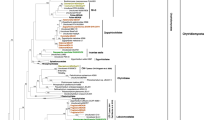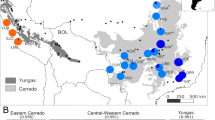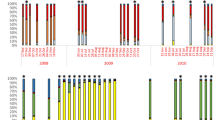Abstract
Contrary to expectation, populations of clonal organisms are often genetically highly diverse. In phytoplankton, this diversity is maintained throughout periods of high population growth (that is, blooms), even though competitive exclusion among genotypes should hypothetically lead to the dominance of a few superior genotypes. Genotype-specific parasitism may be one mechanism that helps maintain such high-genotypic diversity of clonal organisms. Here, we present a comparison of population genetic similarity by estimating the beta-dispersion among genotypes of early and peak bloom populations of the diatom Asterionella formosa for three spring-blooms under high or low parasite pressure. The Asterionella population showed greater beta-dispersion at peak bloom than early bloom in the 2 years with high parasite pressure, whereas the within group dispersion did not change under low parasite pressure. Our findings support that high prevalence parasitism can promote genetic diversification of natural populations of clonal hosts.
Similar content being viewed by others
Log in or create a free account to read this content
Gain free access to this article, as well as selected content from this journal and more on nature.com
or
References
Altermatt F, Ebert D . (2008). Genetic diversity of Daphnia magna populations enhances resistance to parasites. Ecol Letts 11: 918–928.
Anderson MJ, Ellingsen KE, McArdle BH . (2006). Multivariate dispersion as a measure of beta diversity. Ecol Lett 9: 683–693.
De Bruin A, Ibelings BW, Kagami M, Mooij WM, Van Donk E . (2008). Adaptation of the fungal parasite Zygorhizidium planktonicum during 200 generations of growth on homogeneous and heterogeneous populations of its host, the diatom Asterionella formosa. J Eukaryot Microbiol 55: 69–74.
De Meester L . (1996). Local genetic differentiation and adaptation in freshwater zooplankton populations: Patterns and processes. Ecoscience 3: 385–399.
Bell G . The Masterpiece of Nature: The Evolution and Genetics of Sexuality. Croom Helm Ltd.: London, UK, (1982).
De Bruin A . (2006). The potential for coevolution in a aquatic host-parasite system. PhD thesis, Aquatic Ecology. Radboud University: Nijmegen, The Netherlands.
Evans KM, Chepurnov VA, Sluiman HJ, Thomas SJ, Spears BM, Mann DG . (2009). Highly differentiated populations of the freshwater diatom Sellaphora capitata suggest limited dispersal and opportunities for allopatric speciation. Protist 160: 386–396.
De Bruin A, Ibelings BW, Rijkeboer M, Brehm M, van Donk E . (2004). Genetic variation in Asterionella formosa (Bacillariophyceae): is it linked to frequent epidemics of host-specific parasitic fungi? J Phycol 40: 823–830.
Hardin G . (1968). Tragedy of commons. Science 162: 1243–1248.
Jaccard P . (1901). Étude comparative de la distribution florale dans une portion des Alpes et des Jura. Bull Soc Vaud Sci Nat 37: 547–579.
Ibelings BW, Gsell AS, Mooij WM, Van Donk E, Van Den Wyngaert S, De Senerpont Domis LN . (2011). Chytrid infections and diatom spring blooms: paradoxical effects of climate warming on fungal epidemics in lakes. Freshw Biol 56: 754–766.
Little TJ . (2002). The evolutionary significance of parasitism: do parasite-driven genetic dynamics occur ex silico? J Evol Biol 15: 1–9.
R Development Core Team (2011) R Foundation for Statistical Computing Vienna, Austria.
Mann DG, Round FE . (1988). Why didn’t Lund see sex in Asterionella? A discussion of the diatom life cycle in nature. Algae and the aquatic environment 29: 385–412.
Rynearson TA, Armbrust EV . (2005). Maintenance of clonal diversity during a spring bloom of the centric diatom Ditylum brightwellii. Mol Ecol 14: 1631–1640.
Van Donk E, Ringelberg J . (1983). The effect of fungal parasitism in the succession of diatoms in Lake Maarsseveen 1 (The Netherlands). Freshw Biol 13: 241–251.
Sommer U, Adrian R, De Senerpont Domis L, Elser JJ, Gaedke U, Ibelings B et al (2012). Beyond the PEG-model: mechanisms driving plankton succession. Annu Rev Ecol Evol Syst 43: 429–448.
Vos P, Hogers R, Bleeker M, Reijans M, Vandelee T, Hornes M et al (1995). AFLP—a new technique for DNA-fingerprinting. Nucleic Acids Res 23: 4407–4414.
Wolinska J, Spaak P . (2009). The cost of being common: evidence from natural Daphnia populations. Evolution 63: 1893–1901.
Whitehorn PR, Tinsley MC, Brown MJF, Darvill B, Goulson D . (2011). Genetic diversity, parasite prevalence and immunity in wild bumblebees. Proc Biol Sci 278: 1195–1202.
Acknowledgements
We thank Nico Helmsing and Koos Swart for fieldwork support and Suzanne Naus-Wiezer for laboratory assistance. Also, we thank three anonymous reviewers for their constructive and thoughtful comments. ASG is supported by grant 816.01.018 of the Dutch Organization for Scientific Research—Earth and Life Science Foundation (NWO-ALW) to BWI and EvD. LNdSD is supported by grant 817.01.007 of NWO-ALW.
Author information
Authors and Affiliations
Corresponding author
Ethics declarations
Competing interests
The authors declare no conflict of interest.
Additional information
Supplementary Information accompanies this paper on The ISME Journal website
Supplementary information
Rights and permissions
About this article
Cite this article
Gsell, A., de Senerpont Domis, L., Verhoeven, K. et al. Chytrid epidemics may increase genetic diversity of a diatom spring-bloom. ISME J 7, 2057–2059 (2013). https://doi.org/10.1038/ismej.2013.73
Received:
Revised:
Accepted:
Published:
Issue date:
DOI: https://doi.org/10.1038/ismej.2013.73
Keywords
This article is cited by
-
Fungal parasitism on diatoms alters formation and bio–physical properties of sinking aggregates
Communications Biology (2023)
-
Intercomparison of Two Fluorescent Dyes to Visualize Parasitic Fungi (Chytridiomycota) on Phytoplankton
Microbial Ecology (2023)
-
Seasonality of parasitic and saprotrophic zoosporic fungi: linking sequence data to ecological traits
The ISME Journal (2022)
-
Trophic position, elemental ratios and nitrogen transfer in a planktonic host–parasite–consumer food chain including a fungal parasite
Oecologia (2020)
-
Individual-level trait diversity predicts phytoplankton community properties better than species richness or evenness
The ISME Journal (2018)



